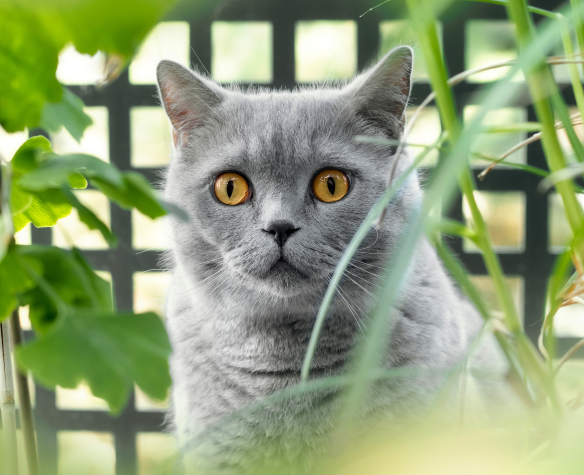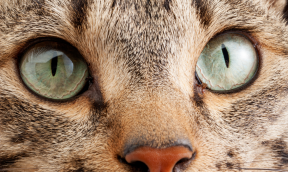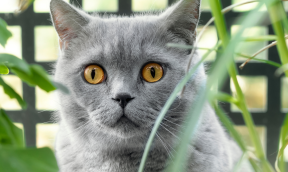
My cat is destroying my plants and my outside space: why? and what can I do to put a lasting stop to it?
CONTENT :
- Why does my cat attack the plants in the garden?
- What damage can a cat cause in the garden?
- Why shouldn’t you punish a cat if it destroys things?
- How do you stop a cat getting into outdoor plants? 7 proven strategies

With the return of warmer weather, you discover the frustrating damage caused by your feline in the garden: plants scratched out, seedlings uprooted, pots used as litter boxes, etc. While these are natural behaviours for cats, they can quickly become problematic for their owners. So how do you stop a cat going into the plants without harming its well-being? Francodex can help you deal with your little wild cats.
Why does my cat attack the plants in the garden?
It can be frustrating to see your cat frantically scratching at your flowers or knocking over a seedling. However, such feline behaviour is rarely malicious.
To find out how to stop a cat going into plants, first you need to understand why they do it.
Domestic cats retain certain behaviours of the wild cat: they are territorial, curious and have highly developed senses.
With its smells, textures, shady spots and potential prey, a garden is a veritable adventure playground for cats
What’s more, boredom and lack of stimulation force them to find things to do as best they can, sometimes to the detriment of your plants.
🌿 Indoors or outdoors, it’s the same battle: indoors and outdoors, the reasons why a cat touches plants are similar, the only difference being that the garden offers far more temptation!
To channel these behaviours, offer them alternatives that are consistent with their needs and do not deprive them of their natural environment.
What damage can a cat cause in the garden?
Cats may seem discreet and stealthy in the garden, but if you take a closer look they can cause a lot of damage.
Here are the main types of damage you might see:
- digging and uprooting plants to mark their territory, cool off or do their business. They can uproot young shoots or damage freshly planted beds;
- using the garden as a litter box in the areas that are easiest to access (soil trays, vegetable garden, window boxes);
- chewing or eating plants out of curiosity or as a purge;
- clawing at structures (tree trunks, fences, stakes or garden furniture) to maintain their claws and mark their territory;
- disrupting biodiversity, as cats are natural predators. They can hunt birds, lizards, insects and rodents, upsetting the balance of the garden’s smaller wildlife.
Lastly, as they explore, they may break stems, knock over pots or trample seeded areas.
Why shouldn’t you punish a cat if it destroys things?
Faced with a flowerbed that’s been trashed, it’s easy to get annoyed. But punishing your cat is a common mistake that is counterproductive and can sometimes damage the human-animal relationship.
If you really want to know how to stop a cat getting into your plants, you need to find out how to make yourself understood. Cats don’t understand punishment, because they are rarely caught in the act of scratching.
Scolding them afterwards creates incomprehension and even fear, without changing their behaviour. They just perceive a change in your attitude, without understanding the cause.
What’s more, a stressed cat can become even more destructive.
How do you stop a cat getting into outdoor plants? 7 proven strategies
Preventing a cat from going into the plants is not about waging battle, but rather a matter of adapting the environment – your garden – to its instincts.
Create an authorised planted area
Cats love plants. Rather than trying to ban them from planted areas altogether, it’s better to give them somewhere with safe plants that they are allowed to explore.
Set up a special corner for your cat with plants that they can chew safely:
- catnip;
- valerian;
- papyrus.
To make this space even more attractive, use a catnip spray to stimulate their desire to play, rub against or roll around in this designated area.
Apply a mild olfactory repellent
Cats hate certain smells, like citrus fruit or vinegar.
However, homemade repellents can sometimes irritate their mucous membranes or damage the plants.
It’s best to opt for a specially formulated product, such as Repuls’off repellent. This uses non-aggressive, aromatic substances to deter cats from approaching treated areas, urinating and scratching.
Apply it to the edges of planters and flowerbeds, and paths they like to use.
Long-lasting solution for big gardens: if you have a large garden or areas that are difficult to monitor at all times, opt for a long-lasting repellent such as outdoor gel repellent which lasts a long time, even in the rain. It acts as an olfactory barrier and is particularly useful in places where your cat has got into the habit of returning.
Use unpleasant textures
Cats instinctively avoid certain sensations under their paw pads:
- sharp gravel;
- wood chip mulch;
- decorative pebbles;
- flexible plastic cat-repellent mats.
Cover the soil around your seedlings temporarily with these materials. This will make it less pleasant to access the area. And they are also highly decorative.
Stop cats scratching in the wrong place
If your cat mistakes your shrubs, posts or wooden flower-bed borders for a scratching post, you need to divert its attention.
Provide it with things they are allowed to scratch nearby, such as a dead tree trunk, a log or a post made of sisal rope.
To protect the targeted surfaces, apply an anti-scratch spray, which leaves a repellent scent on the areas where your pet has made a habit of scratching.
Eliminate the smell of urine or marking
If your feline has already urinated in certain areas of the garden, they are sure to go back again, as the smell acts as a territorial signal. To really stop a cat going into plants, you need to completely remove all traces of marking.
Use Elimin’Urine urine stain remover,an enzymatic urine destroyer that biologically neutralises odorous molecules. Unlike bleach (which should not be used), this product does not increase the cat’s attraction to the area.
Stimulate your cat during the day
A bored cat is a cat that goes exploring. To curb their urge to dig or chew, enrich their daily routine:
- install some interactive toys outdoors;
- set up observation points for them high up;
- offer them food toys, such as foraging mats;
- just play with them!
A mentally stimulated cat will be less likely to take over your flowerbeds just for something to do.
Be regular and consistent
Cats really like routines. To make your routines work, always apply these strategies consistently:
- replace products regularly, especially after rain;
- repeat and praise desired behaviours by offering treats, strokes and extra play time;
- adjust the different solutions according to how your pet reacts.
Lasting change takes time, but it’s perfectly achievable if you act consistently and with kindness.
Can a cat be in danger outside?
Yes – a garden, however welcoming it may be, does entail risks for your cat.
Some ornamental plants (lily of the valley, oleander) are toxic if swallowed. Your pet may also injure itself on gardening tools, swallow pest control products or come into contact with animals that might harm it (rodents carrying parasites, hedgehogs, snakes, etc.).
What’s more, if your pet uses sandbox areas as a litter tray, this behaviour poses a health problem for children, with the risk of contamination by intestinal worms (e.g. roundworms).
If your feline spends time outdoors, make sure the area is safe and free from toxic substances. Also remember to administer an internal and external antiparasitic treatment.
Keeping your cat away from your plants
FAQ: Keeping your cat away from your plants
What is the smell that cats hate most?
Cats have a highly developed sense of smell and react strongly to certain scents.
The most repellent smells to cats are:
- citrus fruits (lemons, oranges);
- white vinegar;
- lavender;
- rosemary;
- lemongrass;
These scents can be used in a targeted way to keep cats away from certain areas.
⚠️ Important! Concentrated essential oils are generally and almost always toxic for cats.
It’s best to use diluted or natural solutions, and you should always test a small amount before applying a larger quantity.
What’s the best recipe for a natural cat repellent?
A simple recipe for a natural repellent is to mix 50% white vinegar and 50% water, with a few lemon or orange zests if you like.
Spray this mixture around your plants, without directly touching the leaves or roots.
You can also put sachets of dried lavender or citrus peel on the ground.
These solutions vary in effectiveness depending on the cat and need to be renewed regularly, especially if it rains.
They should be used in conjunction with a reorganisation of your cat’s environment.
Article rédigé avec le concours du
Dr Vétérinaire Marie MAROSSERO










